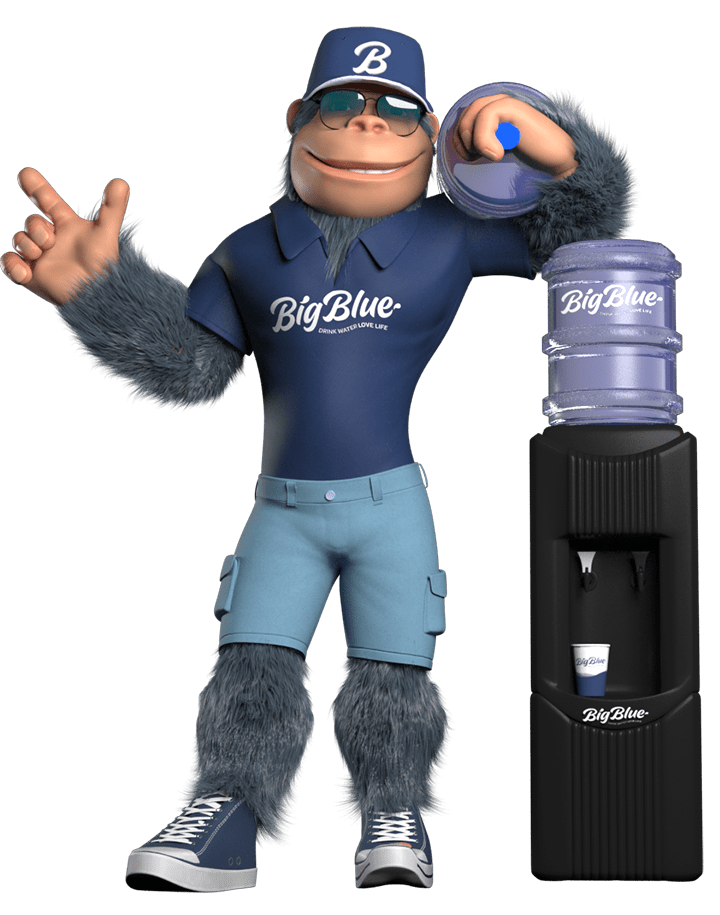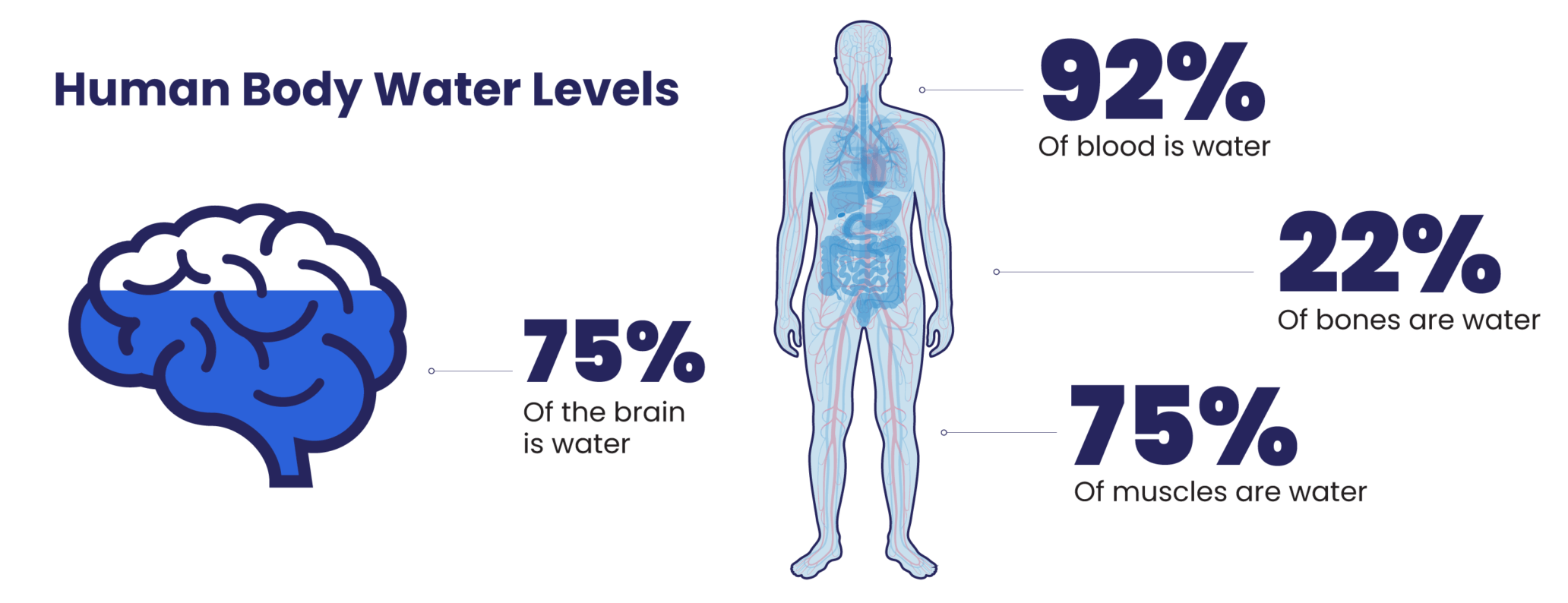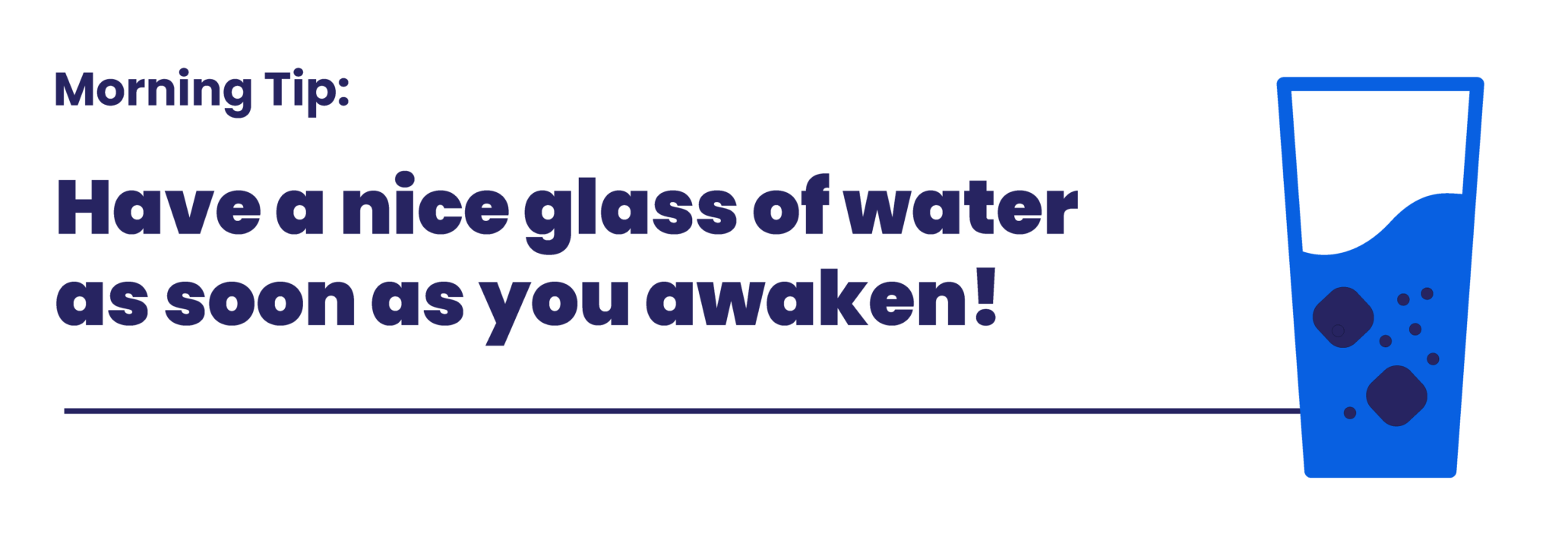Refreshingly good water for your cooler.
Some say that Big Blue’s water cooler water is the best tasting water they’ve ever had. Hard to disagree. But we say we don’t make water – we just make it taste like it should. Just water.
How we source our water in your region
Our water supply process is a little different depending on where you are in New Zealand. No matter where you are though, it all tastes great. After all, you don’t want just any water, right?
Taken from the municipal supply for our Auckland and Hamilton distribution, our water is purified in six steps by the process known as “Reverse Osmosis” to remove potentially harmful contaminants or additives. Reverse osmosis is an advanced water purification method which was invented by the US Navy in the 1970s to create pure drinking water from sea water for its fleets.

Step 1
Pressure pushes water through an activated carbon filter to remove any chemicals like chlorine which are often added to water by treatment plants in an effort to clean the water.
Step 2
Water is then sent through a high density sediment filter and then another pre filter.
Step 3
Then 150-225psi of pressure forces the clean water through a semi-tight RO membrane which has holes that are 1 Millionth of a Millimetre wide which only a water molecule can fit through, contaminants are to big to fit through the holes and are discarded via a waste pump. The water that is received on the other side of the RO membrane is known as “Pure Water”.
Step 4
Water that is pure enough to make it through the entire Reverse Osmosis process is then stored in a completely sterile steel holding tank which has been specifically treated for holding food grade products.
Step 5
Water is pumped from the UV Steriliser straight down into our bottling room and using a special 3 stage sterile flo-tap and hose combination, and it is pumped directly into a one of our UV resistant, refillable and recyclable 15L bottles and sealed air-tight using our sterilized non-spill caps.
Step 6
Once the water is pure and bottled it is date stamped and stored ready for our free water delivery service, often the very next day.
The Tauranga water is initially gathered from three sources – the Tautau, Waiorohi and Waiāri streams. The water at the source is very clean but by the time it passes through several kilometres of land it needs some work before it is suitable for drinking. While the Council does a good job we like to think we make improvements that you will notice!

Step 1
Pressure pushes water through a 1 micron filter, this microfiltration is a type of physical filtration process where water is passed through a special pore-sized membrane to separate micro-organisms and suspended particles. This removes the vast majority of elements you don’t want to drink!
Step 2
Pressure pushes water through an activated carbon filter to remove any chemicals like chlorine which are often added to water by treatment plants in an effort to clean the water. Carbon filters simultaneously remove chlorine taste, odour and organic chemicals that contribute to taste and smell. Activated carbon filters are used in drinking water treatment to remove the natural organic compounds (i.e. tannins) that produce carcinogenic chlorinated by-products during chlorine disinfection of water.
Step 3
Pressure then pushes water through another 1 micron filter, this duplication is an extra step to ensure that the resulting water is ready for bottling.
Step 4
Water that is pure enough to make it through the entire process is then stored in a completely sterile holding tank which has been specifically treated for holding food grade products – Although because of our busy production schedule the water does not stay here for long!
Step 5
As we commence the bottling process water is pumped from the tank via a powerful UV Steriliser straight down into our bottling room. Ultraviolet systems can destroy 99.99% of harmful microorganisms without adding chemicals or changing the water’s taste or odour. The Ultraviolet energy attacks the genetic core of the microorganism and destroys the DNA /RNA thus eliminating the microorganism’s ability to reproduce.
Step 6
Once in the plant we use the water is pumped directly into one of our UV resistant, refillable and recyclable 15L bottles and sealed air-tight using our sterilized non-spill caps. We then date stamped the bottle and store it ready for our free water delivery service, often the very next day.
Our Wellington water is sourced from artesian springs. Clean and pure from natural filtering it has a distinctive and famous taste – it also has no fluoride added to it.
An artesian spring is different from a typical spring in that the water is enclosed by thick layers of sand and rock that prevent the introduction of man-made contaminates. Slowly over the years water is forced through the sand and rock stripping the bacteria and dissolved solids off the water molecules.
Artesian springs are tapped by boring through the rock and sand so that as water is forced upwards, where it is collected. Our Petone bottling plant operates in the same way as our Auckland plant but without the need to pass through a Reverse Osmosis Membrane, our process does remove a number of factors that change the taste of the water though including chlorine.

Step 1.
Pressure pushes water through a 1 micron filter, this microfiltration is a type of physical filtration process where water is passed through a special pore-sized membrane to separate micro-organisms and suspended particles. This is especially necessary with highly organic water like the Petone Water.
Step 2
Pressure pushes water through an activated carbon filter to remove any chemicals like chlorine which are often added to water by treatment plants in an effort to clean the water. Carbon filters simultaneously remove chlorine taste, odour and organic chemicals that contribute to taste and smell. Activated carbon filters are used in drinking water treatment to remove the natural organic compounds (i.e. tannins) that produce carcinogenic chlorinated by-products during chlorine disinfection of water.
Step 3
Pressure then pushes water through another 1 micron filter, this duplication is an extra step to ensure that the resulting water is ready for bottling.
Step 4
Water that is pure enough to make it through the entire process is then stored in a completely sterile holding tank which has been specifically treated for holding food grade products – Although because of our busy production schedule the water does not stay here for long!
Step 5
As we commence the bottling process water is pumped from the tank via a powerful UV Steriliser straight down into our bottling room. Ultraviolet systems can destroy 99.99% of harmful microorganisms without adding chemicals or changing the water’s taste or odour. The Ultraviolet energy attacks the genetic core of the microorganism and destroys the DNA /RNA thus eliminating the microorganism’s ability to reproduce.
Step 6
Once in the plant we use the water is pumped directly into one of our UV resistant, refillable and recyclable 15L bottles and sealed air-tight using our sterilized non-spill caps. We then date stamped the bottle and store it ready for our free water delivery service, often the very next day.
Our Canterbury water starts as the minuncipal supply which is sourced from deep artesian springs. As the story goes, Canterbury artesian water begins its journey from the most isolated and untouched part of the world, the Antarctic. Water vapour is lifted up by the fierce katabatic winds, travelling across the ice-cold South Pacific Ocean before falling as rain, high in the world famous Southern Alps of New Zealand one of the planets most isolated locations and internationally acclaimed as the source of one of the purest natural waters in the world.
The water then spends 70 years (that’s a rough estimate by the way!!) being naturally filtered to purity on its way to deep aquifers under the Canterbury plains which have been known for centuries for the quality of their wonderful water. Reflecting this, our plant in Christchurch is the least technical of our three plants, incorporating high quality activated carbon filters, pre-filters and UV light before being bottled in our sanitised and UV resistant bottles.

Step 1
Pressure pushes water through a 1 micron filter, this microfiltration is a type of physical filtration process where water is passed through a special pore-sized membrane to separate micro-organisms and suspended particles. This removes the vast majority of elements you don’t want to drink!
Step 2
Pressure pushes water through an activated carbon filter to remove any chemicals like chlorine which are often added to water by treatment plants in an effort to clean the water. Carbon filters simultaneously remove chlorine taste, odour and organic chemicals that contribute to taste and smell. Activated carbon filters are used in drinking water treatment to remove the natural organic compounds (i.e. tannins) that produce carcinogenic chlorinated by-products during chlorine disinfection of water.
Step 3
Pressure then pushes water through another 1 micron filter, this duplication is an extra step to ensure that the resulting water is ready for bottling.
Step 4
Water that is pure enough to make it through the entire process is then stored in a completely sterile holding tank which has been specifically treated for holding food grade products – Although because of our busy production schedule the water does not stay here for long!
Step 5
As we commence the bottling process water is pumped from the tank via a powerful UV Steriliser straight down into our bottling room. Ultraviolet systems can destroy 99.99% of harmful microorganisms without adding chemicals or changing the water’s taste or odour. The Ultraviolet energy attacks the genetic core of the microorganism and destroys the DNA /RNA thus eliminating the microorganism’s ability to reproduce.
Step 6
Once in the plant we use the water is pumped directly into one of our UV resistant, refillable and recyclable 15L bottles and sealed air-tight using our sterilized non-spill caps. We then date stamped the bottle and store it ready for our free water delivery service, often the very next day.
Hydro's Top 12 Reasons Why Drinking Water is a Great Idea!

Headaches
Dehydration causes brain tissue to lose water, causing your brain to shrink and pull away from your skull. This triggers your pain receptors, giving you a headache. Dehydration also causes a drop in blood volume, which lowers the flow of blood and oxygen to your brain, also causing headaches.
High Blood Pressure
Blood is normally about 92% water when the body is fully hydrated. When you become dehydrated your blood becomes thicker, causing resistance to blood flow and elevations in blood pressure.
Fatigue
Dehydration causes fatigue as it results in enzyme activity in the body slowing down, causing you to feel tired and sluggish.
High Cholesterol
When your body is dehydrated it produces more cholesterol to prevent water loss from the cells.
Asthma & Allergies
Asthma and allergies are due to irritants causing an inflammatory reaction. When you are dehydrated your body restricts airways to conserve water. During this process histamine production increases, increasing the risk of allergic reactions.
Skin Disorders & Signs of Aging
Dehydration impedes the elimination of toxins through the skin, making the skin more vulnerable to disorders, including dermatitis and psoriasis, along with the signs of ageing, such as premature wrinkling and discolouration.
Joint pain or stiffness
Joints have cartilage padding which is made up mainly of water. When your body is dehydrated your cartilage is weakened and joint repair can be hindered, causing pain and discomfort.
Digestive Disorders
Dehydration and a shortage of alkaline minerals such as calcium and magnesium, can result in digestive disorders, such as ulcers, gastritis and acid reflux.
Constipation
Your body draws much of its water from your colon to provide fluids for other critical body functions. Without adequate water, waste products move through the large intestines much more slowly, or even don’t move a all, resulting in constipation.
Bladder or Kidney Problems
When your body is dehydrated it accumulates toxins and acid waste, creating an environment where bacteria thrive and potentially causing bladder and kidney problems.
Weight Gain
Dehydration can affect the body’s ability to burn off fat and slow down your metabolism, leading to excess fat retention. Drinking cold water can help speed up your metabolism and burn off calories.
Premature Ageing
When chronically dehydrated the body’s organs, including its largest organ, the skin, begins to wrinkle and wither prematurely.
How much water should you drink?

